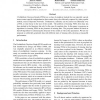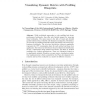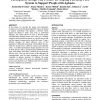346 search results - page 29 / 70 » Individual Differences in Graphical Reasoning |
LISP
2002
13 years 9 months ago
2002
Abstract. Specification diagrams (SD's) are a novel form of graphical notation for specifying open distributed object systems. The design goal is to define notation for specif...
IJAR
2010
13 years 8 months ago
2010
Probabilistic Decision Graphs (PDGs) are a class of graphical models that can naturally encode some context specific independencies that cannot always be efficiently captured by...
TOOLS
2010
IEEE
13 years 7 months ago
2010
IEEE
While traditional approaches to code profiling help locate performance bottlenecks, they offer only limited support for removing these bottlenecks. The main reason is the lack of v...
CHI
2006
ACM
14 years 10 months ago
2006
ACM
In this paper, we describe the design and preliminary evaluation of a hybrid desktop-handheld system developed to support individuals with aphasia, a disorder which impairs the ab...
HICSS
2010
IEEE
14 years 4 months ago
2010
IEEE
Twitter—a microblogging service that enables users to post messages (“tweets”) of up to 140 characters—supports a variety of communicative practices; participants use Twit...



